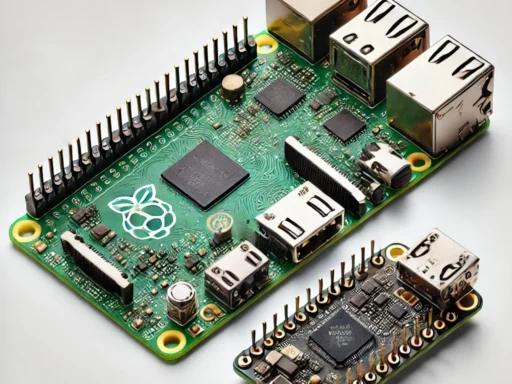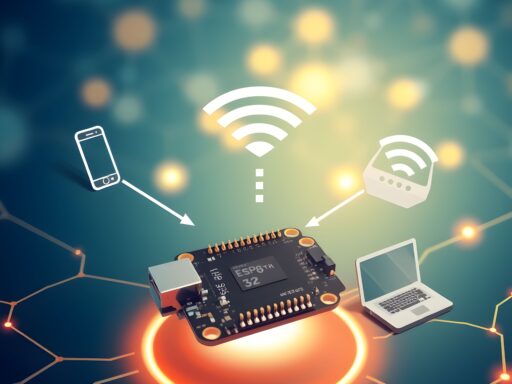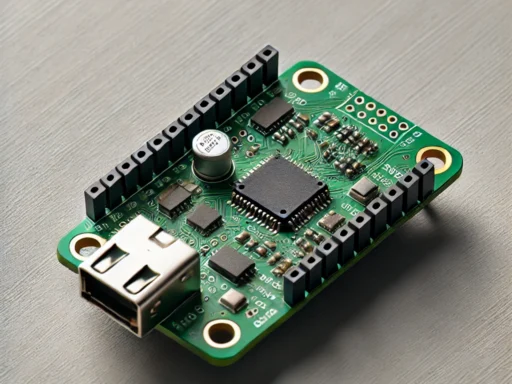Explore how the ESP32 enables efficient, low-power wireless mesh networks for remote monitoring applications, ensuring reliable connectivity across challenging environments.
In remote monitoring applications, establishing reliable and energy-efficient wireless communication networks presents significant challenges, particularly in harsh or inaccessible environments. Traditional wireless technologies often struggle with coverage, power consumption, and data integrity, making them unsuitable for long-term deployment in such scenarios. However, the advent of low-power microcontrollers like the ESP32 has revolutionized the landscape of remote monitoring by enabling the creation of robust mesh networks. The ESP32’s unique capabilities make it a preferred choice for diverse applications, from environmental monitoring to industrial asset tracking.
Evolution of Wireless Mesh Networks
Wireless mesh networks have evolved to address the limitations of conventional networks. Unlike point-to-point or point-to-multipoint systems, mesh networks enable nodes to communicate directly with multiple neighbors, ensuring data is relayed across the network even if some nodes fail. This decentralized approach enhances the network’s resilience and coverage, making it ideal for remote monitoring.
The Rise of ESP32
The ESP32 microcontroller, developed by Espressif Systems, has emerged as a leader in the IoT space due to its powerful dual-core processor, integrated Wi-Fi, Bluetooth capabilities, and support for mesh networking. Its versatility and low cost have made it a popular choice for developers and engineers looking to implement reliable, scalable mesh networks.
Building Low-Power Mesh Networks with ESP32
Understanding Mesh Network Topologies
Mesh networks consist of three primary topologies: full mesh, partial mesh, and hybrid mesh. In a full mesh topology, every node connects directly to every other node, providing maximum redundancy but at a higher cost and complexity. Partial mesh reduces the number of direct connections, balancing redundancy and efficiency, while hybrid mesh combines elements of both, often used in practical deployments to optimize performance and cost.
Setting Up an ESP32 Mesh Network
To set up a mesh network using ESP32, you need to configure the nodes to communicate using the ESP-MESH library. This library simplifies the creation and management of mesh networks, handling tasks such as node discovery, data routing, and network self-healing.
Step-by-Step Guide
- Installing the ESP-MESH Library: Begin by installing the ESP-MESH library through the Arduino IDE or PlatformIO. This library provides essential functions for managing mesh networks on ESP32 devices.
- Configuring the Nodes: Each node in the mesh network requires a unique configuration to participate in the network. The following example demonstrates a basic setup for an ESP32 node:
- Data Transmission: Nodes can send and receive data within the mesh network. The following code snippet illustrates how to send data from one node to another:
- Monitoring and Maintenance: Regular monitoring and maintenance are crucial for ensuring the mesh network’s reliability. This includes checking node health, network latency, and data integrity.
Optimizing Power Efficiency in Mesh Networks
Power Consumption Profiles
The ESP32 microcontroller offers several power modes, including active, light sleep, and deep sleep. Each mode varies in power consumption, with deep sleep consuming the least amount of energy.
Implementing Power-Saving Techniques
To maximize the battery life of ESP32 nodes, it is essential to implement power-saving techniques such as:
- Deep Sleep Mode: Significantly reduces power consumption by shutting down most of the microcontroller’s functions.
- Light Sleep Mode: Conserves power while maintaining faster wake-up times than deep sleep.
Example of Deep Sleep Implementation
By using deep sleep mode, the ESP32 can function for months or even years on a single battery charge, depending on the application and duty cycle.
Enhancing Connectivity in Challenging Environments
Overcoming Physical Obstacles
In many remote monitoring applications, physical obstacles such as mountains, dense forests, or underground structures can hinder communication. Traditional wireless networks often fail in these environments due to limited range and high power consumption. ESP32’s mesh networking capability, however, provides a resilient solution by forming a web of interconnected nodes that can dynamically route data around obstacles.
Case Study: Underground Mining
In an underground mining operation, conditions are harsh, and reliable communication is critical for safety and operational efficiency. By deploying ESP32 nodes throughout the mine, data on air quality, temperature, and equipment status can be continuously monitored. Here’s how a basic setup might look:
In this example, each node acts as a sensor and relay point, ensuring data integrity and continuity even if some nodes fail.
Handling Network Interruptions
ESP32 mesh networks are designed to be self-healing, meaning they automatically reroute data when a node goes offline. This feature is particularly useful in environments where node failure is a possibility, such as in mines with frequent power outages or physical damage to equipment.
Data Security and Integrity in Mesh Networks
Importance of Data Security
In remote monitoring applications, especially in industrial or sensitive environments, securing data transmission is crucial. Unauthorized access to sensor data can lead to operational risks and privacy concerns.
Implementing Advanced Encryption
ESP32 supports various encryption standards, including AES (Advanced Encryption Standard), which is vital for securing communications within the mesh network. Here’s a basic implementation of AES encryption:
This example encrypts data before transmission, ensuring that even if the data is intercepted, it remains unintelligible without the decryption key.
Ensuring Data Integrity
To prevent data tampering, ESP32 supports message integrity checks using cryptographic hash functions. By calculating a hash of the data and sending it along with the data, the receiving node can verify the data’s integrity.
Integration with Cloud Platforms and Data Analysis
Connecting to Cloud Services
ESP32’s ability to connect to cloud platforms like AWS IoT, Azure IoT Hub, and Google Cloud IoT Core allows for real-time data collection, storage, and analysis. These platforms provide robust tools for visualizing data trends and making data-driven decisions.
AWS IoT Integration Example
Here’s how you can send data from an ESP32 node to AWS IoT:
This setup allows continuous data streaming to AWS IoT, where it can be further analyzed and visualized.
Deploying ESP32 Mesh Networks in Smart Cities
Smart City Applications
Smart cities use IoT technologies to improve urban services and infrastructure. ESP32 mesh networks can monitor traffic flow, manage waste collection, and enhance public safety by providing real-time data from distributed sensors.
Example: Smart Street Lighting
A smart street lighting system can reduce energy consumption by adjusting lighting based on environmental conditions. Here’s a simplified example of how ESP32 nodes can control streetlights:
This network of smart lights can communicate through ESP32 mesh nodes, dynamically adjusting brightness to save energy.
ESP32 in Industrial IoT Applications
Role of ESP32 in Industrial Settings
In industrial environments, IoT applications require robust and reliable hardware that can endure harsh conditions. ESP32 stands out due to its durability, flexibility, and capability to form resilient mesh networks, making it ideal for monitoring and controlling industrial machinery.
Case Study: Predictive Maintenance
Predictive maintenance is a critical IoT application in industries, aiming to reduce downtime by predicting equipment failures before they occur. ESP32 nodes can be attached to machinery to monitor parameters like vibration, temperature, and pressure.
Example Setup for Vibration Monitoring
This code reads acceleration data from an MPU6050 sensor connected to the ESP32, which can be used to detect unusual vibrations indicating potential equipment failure.
Data Analysis for Predictive Maintenance
The data collected by ESP32 nodes can be sent to a central system or cloud service for analysis. By applying machine learning algorithms, patterns of wear and tear can be detected, prompting maintenance activities before a critical failure occurs.
Advancements in ESP32 Firmware for Mesh Networking
Recent Firmware Updates
Espressif regularly updates the ESP32 firmware, adding new features and optimizing existing ones. These updates enhance the microcontroller’s performance in mesh networking scenarios, improving efficiency and security.
New APIs and Functionalities
Recent updates include new APIs that simplify the development of mesh networks. For example, the addition of the mesh_set_self_healing() function allows networks to automatically adjust their topology for optimal performance.
This feature ensures that the network remains operational even if individual nodes fail, enhancing overall reliability.
Customizing ESP32 for Specific Use Cases
Tailoring Firmware for Unique Applications
ESP32’s firmware can be customized to fit specific use cases by modifying the underlying code or using libraries designed for particular industries. This customization allows developers to optimize the microcontroller for specialized tasks.
Example: Healthcare Applications
In healthcare, ESP32 can be customized to monitor patient vitals and transmit data securely. A custom firmware might include specific protocols for medical data standards and encryption methods suitable for sensitive health information.
By tailoring the firmware, developers can ensure compliance with healthcare regulations while maintaining high performance.
Future of ESP32 Mesh Networks
Emerging Trends
As IoT continues to evolve, ESP32 mesh networks are expected to integrate more seamlessly with emerging technologies like AI and machine learning. This integration will enable smarter, more autonomous networks capable of real-time decision-making.
Upcoming Hardware Improvements
Future versions of ESP32 hardware are likely to offer enhanced processing power, greater energy efficiency, and improved connectivity options. These advancements will further solidify ESP32’s role in IoT and mesh networking applications.
FAQs
What is a mesh network?
A mesh network is a decentralized network structure where nodes communicate directly with multiple other nodes, allowing data to be relayed through the network even if some nodes fail.
How does ESP32 support mesh networking?
ESP32 supports mesh networking through its ESP-MESH library, which handles node discovery, data routing, and network maintenance, enabling the creation of scalable and robust networks.
Why is ESP32 suitable for remote monitoring?
ESP32 is suitable for remote monitoring due to its low power consumption, built-in Wi-Fi and Bluetooth capabilities, and support for mesh networks, which make it ideal for areas with limited infrastructure.
What are the power-saving features of ESP32?
ESP32 offers several power-saving modes, including deep sleep and light sleep, which significantly reduce power consumption and extend battery life in remote monitoring applications.
How can ESP32 integrate with cloud platforms?
ESP32 can connect to cloud platforms like AWS IoT, Azure IoT Hub, and Google Cloud IoT Core through secure MQTT protocols, enabling real-time data transmission and analysis.
What security features does ESP32 offer for mesh networks?
ESP32 includes encryption standards like AES and supports secure authentication protocols, ensuring that data transmitted within the mesh network is protected from unauthorized access.
Espressif Systems Official Website: Espressif Systems provides comprehensive documentation, development tools, and firmware updates for ESP32.






